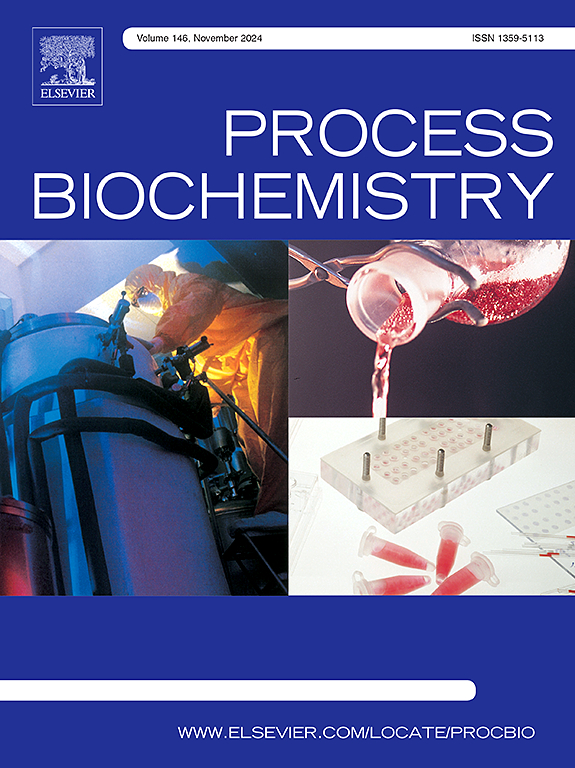Underwater electrical shockwave assisted ethanol/salt two-phase extraction of high-purity cepharanthine from Stephania cepharantha Hayata root
IF 3.7
3区 生物学
Q2 BIOCHEMISTRY & MOLECULAR BIOLOGY
引用次数: 0
Abstract
An underwater electrical shockwave (UES) system was developed to extract cepharanthine (CEP), a potential drug for COVID-19, from the roots of Stephania cepharantha Hayata using an ethanol/salt two-phase system (ETPS) as the solvent. This system combines the purification effect of ETPS with the high efficiency of UES, resulting in high performance, energy efficiency, excellent product quality, and other notable advantages. Under the optimized conditions of ETPS with 25 % ethanol and 22.5 % Na2HPO4, 5 kV discharge voltage, 4 min extraction time and 50 mL/g liquid-solid ratio, the maximum CEP yield of 10.28 ± 0.16 mg/g can be obtained by UES-ETPS extraction, which was significantly higher than that of hot reflux extraction (HRE). Compared with UES extraction with ethanol (UES-ethanol extraction) and HRE, UES-ETPS extraction had the highest CEP purity (50.1 ± 0.23 %), indicating that it had a significant advantage in improving the purity of CEP extract. In addition, energy consumption of UES-ETPS extraction (225 kJ/kg) was significantly lower than that of HRE (2041.2 kJ/kg). Therefore, the UES-ETPS extraction has demonstrated high efficiency, enhanced purity, and reduced energy consumption, making it a promising method for extracting CEP and other bioactive compounds from herbal sources.
水下电激波辅助乙醇/盐两相萃取法提取头铁花根中高纯度头铁花素
以乙醇/盐两相体系(ETPS)为溶剂,建立了一种水下电冲击波(UES)系统,从头飞菊(Stephania cepharantha Hayata)根中提取新型冠状病毒(COVID-19)药物头飞菊素(CEP)。本系统将ETPS的净化效果与UES的高效率相结合,具有高性能、节能、产品质量优异等显著优势。在乙醇浓度为25 %、Na2HPO4浓度为22.5 %、放电电压为5 kV、提取时间为4 min、液固比为50 mL/g的最佳条件下,UES-ETPS提取的CEP得率最高可达10.28 ± 0.16 mg/g,显著高于热回流提取(HRE)。与乙醇提取法(UES-乙醇提取法)和HRE提取法相比,UES- etps提取法的CEP纯度最高(50.1 ± 0.23 %),表明其在提高CEP提取物纯度方面具有显著优势。此外,UES-ETPS提取的能耗(225 kJ/kg)显著低于HRE提取的能耗(2041.2 kJ/kg)。因此,UES-ETPS提取效率高,纯度高,能耗低,是一种很有前景的从草药中提取CEP和其他生物活性化合物的方法。
本文章由计算机程序翻译,如有差异,请以英文原文为准。
求助全文
约1分钟内获得全文
求助全文
来源期刊

Process Biochemistry
生物-工程:化工
CiteScore
8.30
自引率
4.50%
发文量
374
审稿时长
53 days
期刊介绍:
Process Biochemistry is an application-orientated research journal devoted to reporting advances with originality and novelty, in the science and technology of the processes involving bioactive molecules and living organisms. These processes concern the production of useful metabolites or materials, or the removal of toxic compounds using tools and methods of current biology and engineering. Its main areas of interest include novel bioprocesses and enabling technologies (such as nanobiotechnology, tissue engineering, directed evolution, metabolic engineering, systems biology, and synthetic biology) applicable in food (nutraceutical), healthcare (medical, pharmaceutical, cosmetic), energy (biofuels), environmental, and biorefinery industries and their underlying biological and engineering principles.
 求助内容:
求助内容: 应助结果提醒方式:
应助结果提醒方式:


